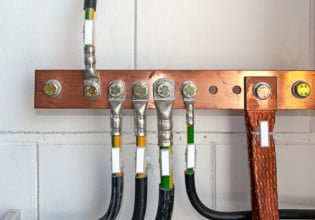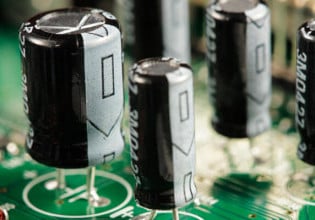National Electrical Code 2023 Basics: Grounding and Bonding Part 2
Learn about the rules to ground alternating-current systems as per the NEC 2023.
To catch up on Lorenzo Mari’s series on grounding and bonding, please follow these links:
There are several voltages and connection types available to power supplies. Some of these arrangements require grounding, while it is permitted in others. Ungrounded systems have high availability but involve significant risks.

Image used courtesy of Pixabay
Part II of Article 250. System Grounding
Sections 250.20 and 250.21 deal with systems to be grounded and systems not required but permitted to be grounded.
Section 250.20. This section classifies the systems that must be grounded – unless prohibited elsewhere in the Code – into four categories.
It states that when grounding a circuit where grounding is permitted, it must follow the rules of Article 250. A corner-grounded delta transformer connection is an example of a system permitted to be grounded. See figure 8.
There are circuits where grounding is prohibited. Sections 503.155, 517.61, 517.160, 668.10, and 680.23(A)(2) show instances.
Section 250.20(A). AC systems of less than 50 V.
AC circuits with less than 50 V shall be grounded in the following cases:
- When powered by transformers with a supply system exceeding 150 V to ground.
The secondary of the transformer must be grounded. An example is a 277Y/480V system feeding the primary side of a transformer whose secondary side supplies 48V to operate solenoid valves or another low-voltage circuit. In this case, the secondary is less than 50 V, and the primary is greater than 150 V to ground.
- When powered by transformers supplied by an ungrounded system.
An example is having one phase of an ungrounded 480 V system feeding the primary of a transformer whose secondary provides a voltage lower than 50 V.
- When installed as overhead conductors outside buildings.
In this case, the system operates at less than 50 V with conductors installed on poles outside the building.
The NEC permits other AC systems operating at voltages less than 50 V to be grounded – the electrician or engineer must make the decision. An example is a 120/32 V transformer. In this case, the secondary is less than 50 V, and the primary voltage does not exceed 150 V to the ground. The 32 V secondary does not need to be grounded, although permitted.
Section 250.20(B) AC systems of 50 V to 1 kV.
The following are cases where AC systems from 50 V to 1 kV supplying premises wiring and premises wiring systems must be grounded.
- When grounding keeps the maximum voltage to the ground of the ungrounded conductors below 150 V.
Figures 1 and 2 show typical applications of this rule. Figure 1 is a 120V, single-phase, 2-wire system. By grounding any of the secondary conductors, the voltage to the ground of the ungrounded conductor does not exceed 150 V.

Figure 1. Single-phase, 2-wire, 480/120 V transformer. Image used courtesy of Lorenzo Mari
This system is typical in small services.
Figure 2 shows a 480-240/120 V, single-phase, 3-wire system with a grounded center tap at the secondary winding and the neutral used as a circuit conductor. Again, the voltage to the ground in the ungrounded conductors does not exceed 150 V.

Figure 2. Single-phase, 3-wire, 480-240/120 V transformer. Image used courtesy of Lorenzo Mari
This system is typical in residential and office services requiring 120 V outlets.
- In a 3-phase, 4-wire, wye-connected system employing the neutral as a circuit conductor.
Figures 3 and 4 show systems that comply with this rule.

Figure 3. 3-phase, 208Y/120V system. Image used courtesy of Lorenzo Mari

Figure 4. 3-phase, 480Y/277V system. Image used courtesy of Lorenzo Mari
This rule also covers the 600Y/347 V system.
These systems are typical in tall buildings and commercial and industrial installations.
- In a 3-phase, 4-wire, delta-connected system using the midpoint of one phase winding as a circuit conductor.
Figure 5 shows a system complying with this rule.

Figure 5. 120/240V, 3-phase, 4-wire, delta system. Image used courtesy of Lorenzo Mari
This system is suitable for supplying power and lighting circuits simultaneously. The three phases supply power, and the 120 V circuits supply lighting.
This connection is also known as high-leg delta because one phase has a higher voltage to the ground than the other two phases - less than the phase-to-phase voltage, however.
Section 110.15 requires marking the high-leg conductor or busbar with an orange outer finish or other effective means if the grounded conductor is also present at each connection point. Section 230.56 requires this marking for the service conductor with the highest voltage.
Section 408.3(E)(1) requires phase B to be the phase with the highest voltage to ground in a switchboard, switchgear, or panelboard. Section 409.102(B) has this requirement for industrial control panels.
Section 408.3(F)(1) requires field marking a switchboard, switchgear, or panelboard containing this system with "Caution___Phase Has ____ Volts to Ground."
Section 250.20(C) AC systems over 1 kV.
This section permits the grounding of systems that supply other than mobile or non-portable equipment.
Section 250.188 specifies how to ground systems supplying mobile or portable equipment.
Section 250.20(D) Systems with a neutral impedance.
As applicable, this section refers to 250.36 or 250.187 for rules to ground these systems.
Section 250.36 applies to systems from 480 V to 1 kV, and Section 250.187 to systems over 1 kV.
Section 250.21. This section applies to AC systems of 50 V to 1 kV that are not required to be grounded.
Section 250.21(A) General.
The following 50 V to 1 kV systems are permitted to be grounded – but not required:
- Electrical systems aimed to supply solely industrial electric furnaces for melting, refining, tempering, and so forth.
- Separately derived systems used for rectifiers supplying only adjustable-speed industrial drives.
- Separately derived systems supplied by transformers with a primary voltage of 1 kV or less, meeting all the following conditions:
◦ The system is for control circuits only.
◦ Only qualified persons service the installations.
◦ Requires continuity of control power.
- Other systems not required to be grounded per 250.20(B).
This section allows using ungrounded systems. Examples of ungrounded systems are 240 V, 277 V, 480 V, and 600 V delta-connected, 3-phase, 3-wire. See figure 6.

Figure 6. Delta system. Image used courtesy of Lorenzo Mari
Ungrounded systems have a high continuity of operation, which is convenient in some processes. The continuity of operation is safer in critical processes because it avoids the accidental opening of the power supply.
Disadvantages include increased exposure to high transient voltages and the possibility of a second ground fault in another ungrounded conductor, which translates into a phase-to-phase fault. See figure 7.

Figure 7. Phase-to-phase fault. Image used courtesy of Lorenzo Mari
Figure 8 shows an example of a permitted grounding connection.

Figure 8. 3-phase, corner-grounded delta. Image used courtesy of Lorenzo Mari
Section 250.26(4) allows any of the three phases to be grounded. This scheme has a grounded conductor that is not neutral but a phase.
Section 250.21(B) Ground Detectors.
This section requires installing ground-fault detectors in ungrounded AC systems operating at not less than 120 V and 1 kV or less.
Install the ground detection sensing equipment close to the power supply.
Ungrounded systems employ ground detectors to activate visual and audible alarms. These alarms warn the people about the existence of a ground-fault condition for them to follow the approved procedure.
Figure 9 shows ground detectors close to the power supply.

Figure 9. Ground detectors close to the power supply. Image used courtesy of Lorenzo Mari
Section 250.21(C) Marking.
This section requires marking the ungrounded systems at the system's source or first disconnecting means with the label "Caution: Ungrounded System Operating - __ Volts Between Conductors."
Key Takeaways of Ground Alternating-Current Systems
- The NEC identifies particular electrical distribution systems and the situations requiring grounding.
- There are four precise systems to be grounded.
- Some AC systems from 50 V to 1 kV are permitted but not required to be grounded. If grounded, they must comply with Article 250.
- Ungrounded systems operating at not less than 120 V and not exceeding 1 kV must have ground detectors.
- Ungrounded systems must have warning marks at the source or first disconnecting means.
- The NEC prohibits grounding in some circuits.






